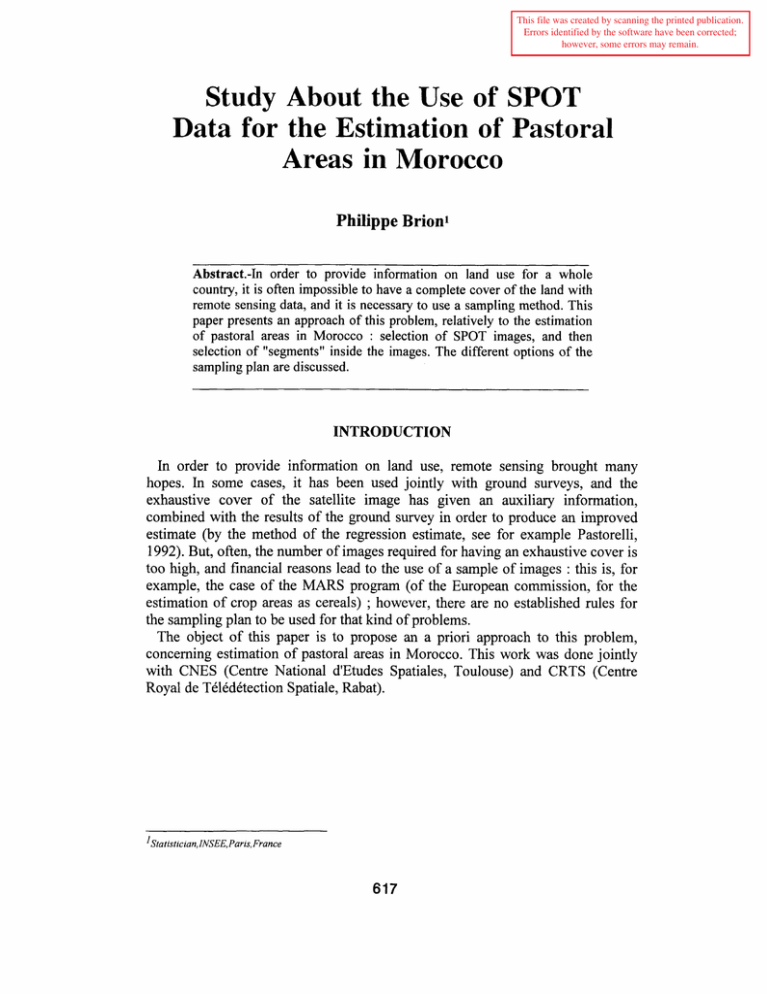Document 11863982
advertisement

This file was created by scanning the printed publication. Errors identified by the software have been corrected; however, some errors may remain. Study About the Use of SPOT Data for the Estimation of Pastoral Areas in Morocco Philippe Brionl Abstract.-In order to provide information on land use for a whole country, it is often impossible to have a complete cover of the land with remote sensing data, and it is necessary to use a sampling method. This paper presents an approach of this problem, relatively to the estimation of pastoral areas in Morocco : selection of SPOT images, and then selection of "segments" inside the images. The different options of the sampling plan are discussed. INTRODUCTION In order to provide information on land use, remote sensing brought many hopes. In some cases, it has been used jointly with ground surveys, and the exhaustive cover of the satellite image has given an auxiliary information, combined with the results of the ground survey in order to produce an improved estimate (by the method of the regression estimate, see for example Pastorelli, 1992). But, often, the number of images required for having an exhaustive cover is too high, and financial reasons lead to the use of a sample of images : this is, for example, the case of the MARS program (of the European commission, for the estimation of crop areas as cereals) ; however, there are no established rules for the sampling plan to be used for that kind of problems. The object of this paper is to propose an a priori approach to this problem, concerning estimation of pastoral areas in Morocco. This work was done jointly with CNES (Centre National dlEtudes Spatiales, Toulouse) and CRTS (Centre Royal de Tdkdktection Spatiale, Rabat). 'statistician,INSEE,paris,~ r a n c e PRINCIPLES OF THE PROPOSED APPROACH Constraints and method The first constraint concerns the purchase of satellite data (here, SPOT images). The impossibility to have a complete cover of Morocco leads us to have a sample of images. Then, since the classification of images does not presently give quite perfect results (there still remains confusions for some types of land use), we are led to having more complete investigations for portions of the images (by photointerpretation for example). So, we propose a two-stage sampling plan for the estimation of pastoral areas: - first, selection of SPOT images ; - second, selection of "segments" inside the selected images. These segments are "surveyed" by photointerpretation, or by a ground survey. They have, for practical reasons, a square shape. Which items of the sampling plan are to be studied ? - The size of the segments has to be chosen. In France, for example, a size of 50 hectares is used for ground surveys because of practical reasons (work of the enumerator). What should be proposed in the context of pastoral areas in Morocco? - Another question concerns the number of segments to be selected inside a SPOT image. - Third, the sample of segments may be selected using a systematic sampling method. Is this method efficient, and if so, what is the gain of precision to be expected ? - The selection of SPOT images is another problem : how many should be selected, and is it possible to use a stratification of the country for the sampling plan ? Then, once the former points have been treated, what global precision is to be expected ? An experimental approach This approach consists in using some existing materials in order to produce, a priori, some quantified results to the former questions. First, three SPOT images, belonging to regions of Morocco with different characteristics (in the upper Atlas, near the Sahara and on arid plateaux) have been classified, especially isolating the item "pastoral area" ; these images have been used for the study of the second stage of the sampling plan. The study of the first stage was realized using data proceeding from a SPOT "Quick-Look-Numerical" (QLN) : these data are obtained by sampling one pixel for six, on row and column, and give a global view of the country, much bigger than a single image. These data were also classified, particularly using the item "pastoral area". The use of these materials permits to have quantified data to study the sampling system before the actual survey : this approach is rather a new one for the problem studied, because until now, we have had at our disposal experiences where the precision is evaluated a posteriori, once the survey has been conducted. At last, it is also important to mention that the subject discussed in this paper is a statistical one, and not a cartographic one. RESULTS First, we will discuss the results concerning the second stage (selection of segments inside the images), and integrate them to those obtained for the first stage (selection of SPOT images). Sample of segments inside the images The three images classified were cut up in segments, using six different grids to define the segments : 200*200m, 400*400m, 600*600m, 800*800m, 1000*1OOOm, 1200*1200m. Size of the segments The variance of the estimate of the mean of a variable Y, using a simple random sample of m segments is approximately equal to : V(estimate ofthe mean) = V(Y) / m (1) if V(Y) is the variance of the variable in the population, and if we do not take into account the sampling fraction f that is very small, so the quantity ( I - - is approximately equal to 1. Table 1 displays the value of V(Y) for the variable "proportion of pastoral areas inside the segments", regarding the three images and the different sizes of segments. Table 1.- V(proportion of pastoral areas inside the segments) Midelt Oujda Segment size 0.132 200 * 200 0.078 Ktaoua 0.165 When the size of the segment increases, the variance V(Y) decreases, because the bigger segments are more homogeneous. But, if we introduce cost elements (corresponding to the time needed to "survey" the segments, e.g. proportional to the area of the segments, or at least to the square root of this area), we see that the decrease of variance is not sufficient enough to compensate cost increase. So, according to the results obtained for these three images located in different regions of Morocco, it seems better to use small segments (200*200m). Efficiency of the systematic sampling method This method consists in selecting segments located on a grid, rather than taking them completely randomly. The size of the grid may vary, and is related to the sampling fraction. Having cut up three images in segments makes it possible to calculate exactly the variance of the estimate with this method (by calculating the results of all possible systematic samples, which are in limited number), and to compare it to the one obtained by Eq. 1, for the three sites, different sizes of segments and for different sampling rates. The results are that, generally, the systematic method is more efficient that simple random sampling, and, on an average, the gain of variance of the estimate is between 30% and 40%. These results are similar to those obtained by Dunn and Harrison (1993). Precision of the estimation inside the images Table 2 gives the coefficient of variation for the estimate of the proportion of pastoral areas inside each image for a systematic sampling of segments of 200*200m, the sampling fraction being 11100. Table 2.-Precision of the estimates inside the images 1mag.e coefficient of variation Midelt 2.3 % Oujda 1.1 % Ktaoua 9.9 % - The coefficient of variation is defined as the ratio from the square root of the variance of the estimate of a characteristic to the value of this characteristic. Selection of SPOT images Using the QLN makes it possible to reconstruct "approximate" SPOT images for the whole country. The values obtained from these images constitute the basis to evaluate the global precision of the sampling plan. Variance of the estimate for a two-stage sampling plan If the selection for the first stage is with equal probabilities, the variance of the estimate f of the total is : T. (Y) pastoral area of the image a Z, is the variance of the estimate of the total T, (Y) according to the method of selection of segments inside the image Results from the first part (selection of segments inside the images) are used for the estimation of the Za , and the data of QLN give information about Sf. Results Average results (calculated with the three images) for the second stage were used, and Table 3 gives the precision of the global estimate of pastoral areas for Morocco, with different numbers of images selected at the first stage, and 400 segments of 200*200m selected in each image. Table 3.-Precision of the estimate of pastoral area for Morocco Number of surveyed images Coefficient of variation of Relative share of the second the estimate (%) stage in the total variance of the estimate (%) 20 12.0 2.1 The share of the variance which depends from the second stage is small, that means that the variance between images brings the most important part of this variance. So, it is possible to have, for the second stage, a smaller sample. If we take 30 images and 30 segments inside each image, we obtain a coefficient of variation of 10.5%. The second result of Table 3 is that, even when the sampling rate for the first stage is high, for example 100 images selected within the 115 "possible" which cover the whole country, there still remains a consistent value of the variance of the estimate. Use of a stratification A "rough" stratification was used, classifying all 115 images in 9 classes : selecting 30 images using this stratification (and 30 segments inside each image), the coefficient of variation of the estimate for pastoral areas is 8.9% (instead of 10.5% without stratification). CONCLUSION The most important result of this study is the great part of the variance of the estimate due to the first stage of the sampling plan, that is the fact of selecting images among the 115 images covering the country. This result is well known for sampling questions, and one way to take it into account and to improve the efficiency of the method might be to have smaller primary units : using portions of SPOT images for the first stage could be a response to that problem. Then, the results obtained in this paper should not be considered as exact values of the precision to be obtained with such a method, but rather as approximations based on an experimental approach. Finally, we considered this problem as an "instantaneous" estimation, trying to evaluate the pastoral areas of the country for one year. To evaluate the evolution between two years, or more, should lead to other propositions and results for the sampling plan. REFERENCES Cochran, W.G., 1977, Sampling techniques, 3rd ed, Wiley, New York Dunn, R., Harrison, A.R., 1993, Two-dimensional systematic sampling of land use, Applied Statistics 42 n04 Pastorelli, R, 1992,Superficies agricoles a partir d'images satellite, Courrier des statistiques n061-62, Paris Rapport CNES, 1995, Projet Geostat Maroc, etude statistique, CNES, Toulouse BIOGRAPHICAL SKETCH Philippe Brion graduated from Ecole Polytechnique (Paris) and ENSAE (Ecole Nationale de la Statistique et de llAdministrationEconomique, Paris). He was in charge of the sampling methodology in SCEES (statistical department of the French Ministry of Agriculture) from 1980 to 1989, and is now working in INSEE (Institut National de la Statistique et des Etudes Economiques) on methodological problems for statistical cooperation (developing and transition countries).







